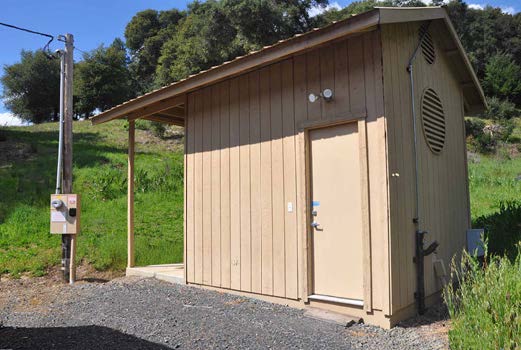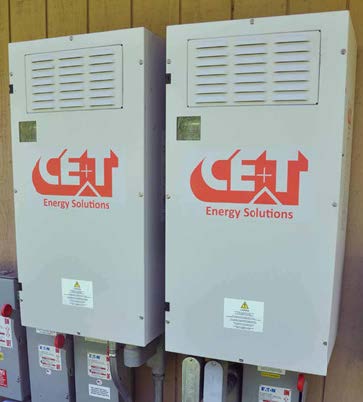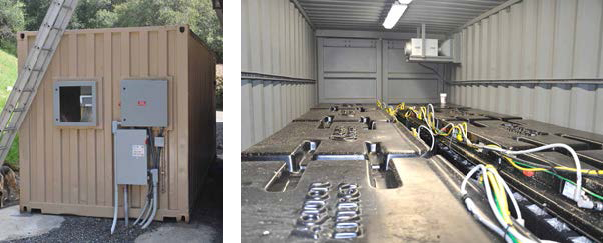Background
The Lavorante Vineyard is a forty-six-acre property that was originally developed by the Puccioni Family in 1904 when it was a part of the Puccioni Ranch. The land was cleared and leveled by hand with the use of mules. Plums, apples, and grapes, principally zinfandel, were grown using water from nearby springs. The property was separated from the Puccioni Ranch in the 1950s, and a dam forming a 1.1-acre pond was installed in the 1960s by the U.S. Army Corps of Engineers.
Today, three wells support two separate water systems, one for agricultural use, including irrigation for ten raised-bed gardens, and the other for domestic water supply for the two homes, two barns, and two chicken houses on the property. Since the wells are all at a low elevation and 30,000 gallons of storage are at a 240- foot higher elevation, transfer pumps are required. In total there are nine pumps used for water transfer, pressurization, and fire suppression. The 480 Vac, 3-phase power for the property is 100% distributed underground.
Due to Lavorante’s remote geographic location and its end of PG&E distribution line utility connection, there is a high probability that severe weather events combined with vulnerability to fallen trees, wildfires, and/or utility mandated regional grid curtailments when winds are high, do result in power outages of indeterminate length. In fact, shortly after purchasing the property, a six-day power outage occurred which resulted in loss of most frozen and refrigerated food, and inability to heat the house.

In 2016/17, a total of 20 outages of various durations were recorded. During grid outages it is important for Lavorante to maintain power to the property to preserve water pumping and firefighting capabilities, refrigeration, heating and lighting using sources other than generators, since the refueling of generators could be delayed by road and bridge failures caused by fires or earthquakes. Prior to installing the Solar + Storage microgrid, a large propane-powered generator provided backup power. However, the increasing cost of propane required to service increasing outages became a major operating expense.
Over the past five years, the area suffered three serious fires, none of which actually reached the property, but remained serious threats. The Kincade fire burned 77,758 acres, until fully contained on November 6, 2019. This fire threatened over 90,000 structures and caused widespread evacuations throughout Sonoma County, including the communities of Geyserville, Healdsburg, and Windsor. This was the largest wildfire ever experienced in Sonoma County, and when the winds didn’t let up, a mandatory evacuation order was issued.
At evacuation, the property had already been operating in microgrid mode for 36+ hours. Thus, the property was completely reliant on the Solar + Storage microgrid, backed up by the propane powered generator. The microgrid kept the wells pumping and the storage tanks full, allowing fire suppression sprinklers to continuously protect all main structures as well as numerous outbuildings. 2-1/2 days later, PG&E power was still off, but with pumps still running, all the protected buildings along with surrounding vegetation were completely soaked. If any embers from the fire had reached the property, these structures would have been well protected. In its first real-time emergency situation the Solar + Storage microgrid passed the test with flying colors! Note that the propane generator did not run for the four-day period PG&E curtailed grid power. So, the Solar+ Storage microgrid supplied all power, without genset assistance.

Why Solar + Storage?
Due to the potentially adverse consequences of ongoing outages as well as the high costs of PG&E power, ($14K in 2016, and increasing 4% to 5% per year), it was clear that a combination of solar power, paired with energy storage and backed up by a propane-powered generator would be highly desirable. The payback of such a system was heavily dependent on the federal investment tax credit which required that the solar/battery system feed energy back into the utility grid. This resulted in the need for a “hybrid” grid-connected system that could also function as an “island” power system whenever grid power was unavailable.
The property owner is an experienced industrial electrical equipment manufacturer as well as a registered professional engineer in the State of California. His expertise and experience were used to draw up an initial system specification. He quickly found that local solar contractors were not capable of handling the full scope of his specification due to its complex control requirements and limited experience with high-voltage batteries. Aquion Energy, his preferred battery vendor, recommended the Station A division of NRG Corporation who subsequently contracted with Lavorante Vineyard to supply a solution which matched the owner’s original specification.
The specification required that the new hybrid solar/battery power system be capable of supplying an average load of 8 kW, 24 hours/ day during the shortest winter days, and would be supplied at 480 Vac, three-phase, 60 Hz to match the existing utility interconnection. Supplemental generator power would be made available during rainy or overcast days, to charge the batteries and support the loads during the charging operation.
Onsite loads include a 7.5 kVA, three-phase heat pump which is part of a geothermal heating/cooling system for the main residence. Such ground-loop geothermal systems are much more energy efficient than conventional air conditioners in the summer and propane boilers in the winter, which minimizes overall energy use and demand on batteries. Other electrical loads include a three-phase hydraulic pump motor for the residential elevator, and single-phase and three-phase water pumps with high inductive inrush currents that support the above described water systems. Other around-the-clock loads include two 16 ft. electric gates, multiple refrigeration loads and security lighting.
The engineers at Station A, together with the owner researched various photovoltaic, battery, and inverter technologies and suppliers. A U.S. manufacturer of solar panels was selected for local support reasons. Aquion batteries were chosen because they used inflammable saltwater storage technology, operated over a wide temperature range, and required virtually no maintenance. While the Aquion batteries were bulky, space was not an important consideration: eight large cells with 175 kWh capacity were easily placed in a standard 20-foot weatherproof shipping container.

CE+T converters were chosen for their unique functions such as multi-port capability which includes utility grid and genset, PV, and battery charging and discharging connectivity, grid forming, grid following, and bi-directionality, etc. A Kaco PV inverter was selected for basic solar to grid export. A pair of Basler isolation relays were installed to meet the utility’s “no-backfeed” safety requirements when the system is in islanded mode. Finally, ELM FieldSight LLC was chosen to build and program the overall system site controller because of their known skills in designing controllers for more complex power systems.
Final System Configuration:
- Full load 3-phase contactor, controlled by pair of Basler isolation relays, for connecting 480 Vac, 3-phase main load circuit breaker panel to PG&E utility grid
- 480 Vac 3-phase connection from PV/battery system to main load circuit breaker panel
- 51 kW photovoltaic panels with oversized underground cables for connecting to inverters with minimal line losses
- CE+T Energy Solutions: Two, 30 kW Stabiliti 30C3 multiport converters
- Zig-zag transformer: Converts 3-wire delta inverter output to 4-wire output with neutral
- Kaco: 30 kW PV Inverter
- 175 kWh Aquion Energy batteries
- 51 kW Cummins propane powered generator with automatic transfer switch
- ELM FieldSight LLC site controller
- Assorted fused disconnect switches for protecting all electrical components
Operation:
Currently, the microgrid system is grid connected and feeds excess power back into the grid for power credits. During an outage, the system rapidly transitions to islanded microgrid mode, formed by the AC-DC-DC converters, sourced from PV, battery storage, or both. A propane generator is integrated into the system for added support if sunlight is inadequate or during temporary loss of battery or converter resources.
Startup Issues and Solutions:
After initial commissioning of the microgrid system, a number of faults and shutdowns occurred which, after analysis, were determined to be caused by high inductive inrush current from the many electric motors, mostly pumps, which were part of the electrical loads on the property. Both single-phase and three-phase “soft-start” relays were installed reducing the number of faults but not completely resolving the problem. The ultimate solution was reached by replacing the single multi-port inverter with a pair of CE+T third generation 30C3 converters which were designed to handle higher current inrush. These new inverters together with the soft start relays completely resolved this problem. The second inverter also increased system flexibility since the two inverters could operate either separately or in parallel, depending on load requirements, as directed by the site controller.
Timeline:
- 2006: Generator was sole backup
- 2013/14: System analysis and detailed design completed by Station A
- 2015: Initial Solar + Storage system installation completed, including testing and commissioning
- 2017: System upgraded from a single multiport converter to a pair of 30C3 (3rd generation) converters
- 2018: Significant load growth supported: including on-site EV charging infrastructure, new shop tools, etc.
- 2017 to present day: Converters now operate in tandem to share and better support both transient and steady state loads up to 60 kVA from 30k VA, and the converter pair provide a level of system redundancy not available with the earlier generation single-converter installation
Key Lessons Learned:
- After initial interconnection in 2015, the system worked intermittently due to higher than expected in-rush currents from pump loads, excessive parasitic losses on transformers, additional loads, and more than expected/complex PG&E interconnection requirements.
- Transformer losses were discovered as part of the load survey / load analysis work, perhaps even prior to the load analysis, but were an order of magnitude greater than anticipated and were resolved by replacing 5 or 6 transformers, reducing tare losses dramatically.
- Single-phase pump start loads were mitigated by installing soft start kits, replacing/swapping pumps.
- Complex PGE interconnection requirements required the use of 2 Basler boxes voting/agreeing in parallel to island.
- Both average and peak loads grew over time, which required the replacement of the original multiport converter with two.
- CE+T 30C3 Stabiliti power converters have more robust microgrid functionality, providing a level power support and system redundancy far superior to their previous generation.
- Lastly, the only remaining negative in the system is the restricted rate of charging of the Aquion batteries. During periods of overcast weather, the microgrid loads will deplete the batteries at night, and if overcast the following day, we may not make it through the following night without the generator turning on to carry the loads while slowly recharging the batteries. This results in higher than expected propane use, which may require the installation of a larger propane tank to support such seasonal demands.
Return on Investment:
The main economic advantage of the PV/battery micro-grid system is its return on investment. To date, the total cost of the system is $309,507 which includes all of the electrical components, sales tax, site preparation including leveling, trenching, pier setting, cement work, conduits and cable, and complete installation and commissioning. The system qualified for the 30% federal investment tax credit which brought net after-tax cost down to $206,338.
Before the microgrid was completed, annual PG&E electric utility costs for the entire property including two barns, one with a workshop, two residences, and multiple outbuildings were approximately $14,000 and growing ~4%-5%/year. After completely eliminating the PG&E electricity costs, the internal rate of return (IRR) over a 20-year period is equal to 6.8%, a net return not attainable at the time through low risk investments like CDs, etc. However, since no federal or state income taxes apply to these PG&E savings, and assuming a 26% Federal income tax rate, the actual return on investment is equivalent to 9.2%.
Also, the $14K annual PG&E costs do not include the additional electricity costs of charging the Tesla battery. The Tesla was purchased after the microgrid was installed. These additional savings should increase the IRR above 10%. Thus, the microgrid power system is not only a very attractive as well as low risk investment but also a vital emergency power supply. Also, at this rate of return, future system maintenance and replacement costs can be easily afforded.
Peace of Mind:
While qualitative in nature, the satisfaction that comes from knowing that the property is relatively safe and self-contained, regardless of earthquakes, fires or pandemics is quite comforting.